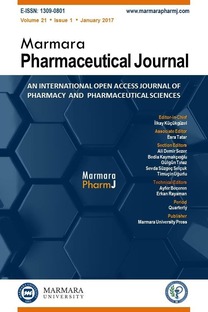Preparation and characterization of herbal emulsion formulations
___
Tanrıverdi ST, Özer Ö. Novel topical formulations of terbinafine-HCl for treatment of onychomycosis. Eur J Pharm Sci 2013;48:628-36.Amit M, Stavans J. Stability of emulsions with nonadsorbing polymers. Langmuir 1996; 12: 301–4.
Lambers H, Piessens S, Bloem A, Pronk H, Finkel P. Natural skin surface pH is on average below 5, which is beneficial for its resident flora. Int J Cosmet Sci 2006; 28:359-70.
Tadros TF, Vincent B. Encyclopedia of Emulsion Technology Editor: Becher P. Marcel Dekker, New York. 1983.
Schmidts T, Dobler D, Guldan A-C, Paulus N, Runkel F. Multiple W/O/W emulsions—using the required HLB for emulsifier evaluation. Colloids Surf A Physicochem Eng Asp 2010; 372: 48–54.
Shrikumar S, Maheshwari U, Sughanti A, Ravi TK. WHO guidelines for herbal drug standardization, 2006.
Thakur L, Ghodasra U, Patel N, Dabhi M. Novel approaches for stability improvement in natural medicines. Pharmacogn Rev 2011; 5: 48-54.
Mishra AP, Saklani S, Milella L, Tiwari P. Formulation and evaluation of herbal antioxidant face cream of Nardostachys jatamansi collected from Indian Himalayan region. Asian Pac J Trop Biomed 2014; 4: 679-82.
Gade J, More S, Bhalerao N. Formulation and characterization of herbal cream containing Fenugreek seed extracts. Int J Sci Res 2015; 5: 1-4.
Dhase AS, Khadbadi SS, Saboo SS. Formulation and evaluation of vanishing herbal cream of crude drugs. AJEthno 2014; 1: 313-8.
Ho KM. Proper choice of base of topical medicaments. Med Bull 2006; 11: 7-8.
Alğın Yapar E, İnal Ö, Erdal S. Design and in vivo evaluation of emulgel formulations including green tea extract and rose oil. Acta Pharm 2013: 63; 531-44.
Cosmetic Dermatology: Principles and Practice. Editor: Baumann L. The McGraw-Hill Companies, Inc. Chine. 2009, pp 294.
Roveroni-Favaretto LHD, Lodi KB, Almeida JD. Topical Calendula officinalis L. successfully treated exfoliative cheilitis: a case report. Cases J 2009; 23: 9077.
Hamburger M, Adler S, Baumann D, Förg A, Weinreich B. Preparative purification of the major anti-inflammatory triterpenoid esters from Marigold (Calendula officinalis). Fitoterapia 2003; 74: 328-38.
Wölfle U, Seelinger G, Schempp CM. Topical Application of St. John’s Wort (Hypericum perforatum). Planta Med 2014; 80: 109-20.
- ISSN: 1309-0801
- Yayın Aralığı: Yılda 6 Sayı
- Başlangıç: 1985
- Yayıncı: Marmara Üniversitesi
Revika RACHMANIAR, Camellia PANATARANI, I Made JONI, Marline ABDASAH, Taofik RUSDIANA
Mohammad-Taghi MORADI, Ali KARIMI, Somayeh ALIDADI, Leila HASHEMI
Prescribing pattern of antidiabetic drugs in type 2 diabetic patients of Noakhali city in Bangladesh
Anwesha CHOWDHURY, Niloy SEN, Sujan BANİK
Antioxidant and cytotoxic properties of novel spirocyclic benzothiazolines
GÖKÇE CİHAN ÜSTÜNDAĞ, NURTEN ÖZSOY, EZGİ ÖZTAŞ, NİLGÜN LÜTFİYE KARALI, Gültaze ÇAPAN
SEVDA GÜZEL, Roman PAVELA, AHMET İLÇİM, GAMZE KÖKDİL
BEDRİYE SEDA KURŞUN AKTAR, Emine Elçin ORUÇ EMRE, Ayşegül KARAKÜÇÜK İYİDOĞAN, AYŞE ŞAHİN YAĞLIOĞLU, İBRAHİM DEMİRTAŞ, ŞABAN TEKİN
AHMET AKICI, N. İpek KIRMIZI, GÖKHAN GÖÇMEN
Characterization of Sideritis trojana Bornm. essential oil and its antimicrobial activity
HASAN KIRMIZIBEKMEZ, Nursenem KARACA, Betül DEMİRCİ, FATİH DEMİRCİ
Kailas Krishnat MALI, Shashikant C DHAWALE, Remeth J DIAS, Vijay D HAVALDAR, Pankaj R KAVITAKE
Gel permeation chromatographic method for drug protein binding studies
